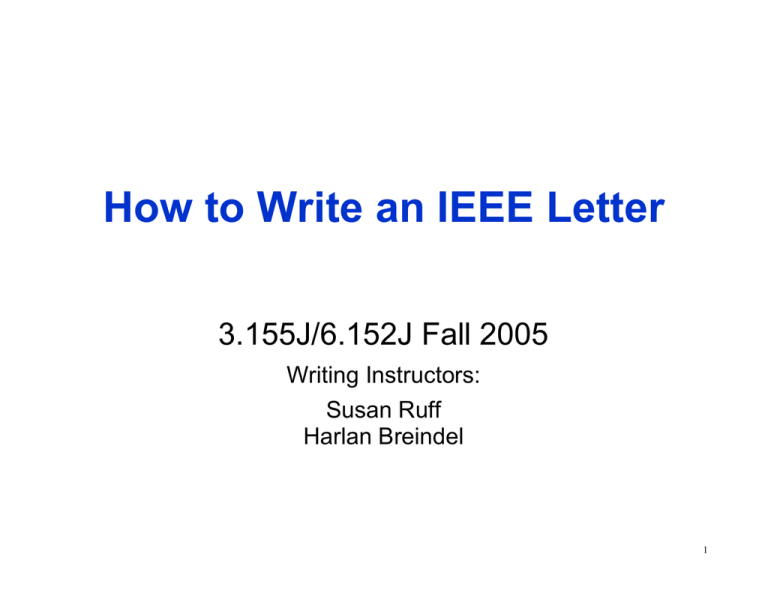How to Write an IEEE Letter 3.155J/6.152J Fall 2005 Writing Instructors: Susan Ruff
advertisement

How to Write an IEEE Letter 3.155J/6.152J Fall 2005 Writing Instructors: Susan Ruff Harlan Breindel 1 Use the IEEE Letter Format Microelectronics Letters Journals: IEEE Electron Device Letters Applied Physics Letters Available online at libraries.mit.edu Click on VERA (Virtual Electronic Resource Access) LaTeX and Word templates available at www.ieee.org 2 To stay within the 3-page limit, focus your letter. Purpose of your letter: To evaluate your fabrication process (Analyze MOS C-V data. Use any unexpected results to analyze the process.) Letters Audience: Familiar with micro/nano processing May specialize in a different field English may not be first language 3 The Introduction provides the context for your research and a clear purpose statement Background/Context: Identify a gap in the current state of the field Summary of Ma et al: In P+ poly Si gate P-MOSFETs, boron penetration from the gate into the substrate is a problem. This problem is currently solved by nitridation of the oxide, but current methods of nitridation are problematic because high temperatures are required. Purpose of Ma’s work: “In this work, we will show that 900 ~ 950°C low-temperature two-step furnace N2O anneal [14] can effectively prevent boron diffusion from P+ poly gates into Si substrate.” Purpose of your work: to evaluate the fabrication process 4 The Experiment = Methods • Explain what was done and why • Provide enough detail to give context for the results, to give your audience confidence in you, and to permit the work to be reproduced. • Your audience is familiar with microelectronics processing, so you need not go into great detail. • Write in past tense without “I” or “we” 5 The Results contain only objective information e.g. measurements, calculated values, and objective observations The section must contain text. Tables and Figures should be able to “stand alone” for readers who skim. Define variables and give units of measure. Structure visuals to emphasize important information. • Use captions to direct audience to main point of visual. • Remove unnecessary details, e.g., grid lines • In tables, items to be compared should be placed near each other Image removed due to copyright restrictions. 6 The Discussion contains your evaluation of the fabrication process. What do the differences between measured and expected values tell you about the process? • Use quantitative evidence to support your claims. • Be sure to discuss unexpected results. • Structure the discussion carefully—your goal is to communicate to your readers, not just to put information on paper. If a reasonable researcher could dispute your statements, they belong in the Discussion, not in the Results. 7 The Conclusion summarizes the most important points of the letter. What do you want your audience to remember? “In conclusion, low-temperature nitrided oxides obtained by two-step N2O anneal have been shown to be a good barrier to boron penetration. Significantly, these N2O-annealed oxides can avoid the high-density electron trapping problem common in NH3-nitrided oxides and requires only a low thermal budget.” (Ma, et al) 8 Title, Byline, Abstract, & References Title: Should be specific enough to attract the right audience. Use of Capacitance-Voltage Measurements for Characterization of a new poly-gate MOS process Byline, etc: Give name, e-mail, subject number, lab group, date. Abstract: “The abstract should be limited to 50–200 words and should concisely state what was done, how it was done, principal results, and their significance. The abstract will appear later in various abstracts journals and should contain the most critical information in the paper.” —IEEE Information for Authors References: Use IEEE style. 9 Appendices should not be referenced in the body of the Letter Appendix A: Results Graphs showing the raw data (I-V and C-V curves) A table summarizing all measured & calculated parameters for easy comparison. See course slides for the data to include. Appendix B: Calculations Show how you obtained the calculated results in Appendix A. 10 Drafting your report Allow time over several days. Organize data, compare measured to expected, make and test conjectures. Make a writing plan; don’t write sections in order. Write. Sleep Read Revise Print & proofread. 11 Writing Help The Writing Center web.mit.edu/writing The Mayfield Handbook of Scientific and Technical Writing https://web.mit.edu/course/21/21.guide/www/home.htm Academic Integrity at the Massachusetts Institute of Technology: A Handbook for Students http://web.mit.edu/due/handbook.pdf “The Science of Scientific Writing” by Gopen & Swan A Google search will generate many hits. Writing Tutors Susan Ruff Harlan Breindel 12




